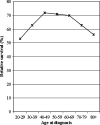An overview of prognostic factors for long-term survivors of breast cancer
- PMID: 17377838
- PMCID: PMC2217620
- DOI: 10.1007/s10549-007-9556-1
An overview of prognostic factors for long-term survivors of breast cancer
Abstract
Background: Numerous studies have examined prognostic factors for survival of breast cancer patients, but relatively few have dealt specifically with 10+-year survivors.
Methods: A review of the PubMed database from 1995 to 2006 was undertaken with the following inclusion criteria: median/mean follow-up time at least 10 years; overall survival and/or disease-specific survival known; and relative risk and statistical probability values reported. In addition, we used data from the long-standing Eindhoven Cancer Registry to illustrate survival probability as indicated by various prognostic factors.
Results: 10-year breast cancer survivors showed 90% 5-year relative survival. Tumor size, nodal status and grade remained the most important prognostic factors for long-term survival, although their role decreased over time. Most studies agreed on the long-term prognostic values of MI (mitotic index), LVI (lymphovascular invasion), Her2-positivity, gene profiling and comorbidity for either all or a subgroup of breast cancer patients (node-positive or negative). The roles of age, socioeconomic status, histological type, BRCA and p53 mutation were mixed, often decreasing after correction for stronger prognosticators, thus limiting their clinical value. Local and regional recurrence, metastases and second cancer may substantially impair long-term survival. Healthy lifestyle was consistently related to lower overall mortality.
Conclusions: Effects of traditional prognostic factors persist in the long term and more recent factors need further follow-up. The prognosis for breast cancer patients who have survived at least 10 years is favourable and increases over time. Improved long-term survival can be achieved by earlier detection, more effective modern therapy and healthier lifestyle.
Figures






References
-
- {'text': '', 'ref_index': 1, 'ids': [{'type': 'PubMed', 'value': '15761078', 'is_inner': True, 'url': 'https://pubmed.ncbi.nlm.nih.gov/15761078/'}]}
- Parkin DM, Bray F, Ferlay J et al (2005) Global cancer statistics, 2002. CA Cancer J Clin 55:74–108 - PubMed
-
- {'text': '', 'ref_index': 1, 'ids': [{'type': 'PubMed', 'value': '14684501', 'is_inner': True, 'url': 'https://pubmed.ncbi.nlm.nih.gov/14684501/'}]}
- Sant M, Aareleid T, Berrino F et al (2003) EUROCARE-3: survival of cancer patients diagnosed 1990–94-results and commentary. Ann Oncol 14(Suppl 5):v61–118 - PubMed
-
- {'text': '', 'ref_index': 1, 'ids': [{'type': 'PubMed', 'value': '12888367', 'is_inner': True, 'url': 'https://pubmed.ncbi.nlm.nih.gov/12888367/'}]}
- Botha JL, Bray F, Sankila R et al (2003) Breast cancer incidence and mortality trends in 16 European countries. Eur J Cancer 39:1718–1729 - PubMed
-
- ACS: Cancer facts and figures 2005. Atlanta, 2005
-
- Janssen-Heijnen MLG, Louwman WJ, van de Poll-Franse LV et al (2005) Van meten naar weten. 50 jaar kankerregistratie. Integraal Kankercentrum Zuid (IKZ), Eindhoven, 104 pp
Publication types
MeSH terms
Substances
LinkOut - more resources
Full Text Sources
Other Literature Sources
Medical
Research Materials
Miscellaneous

